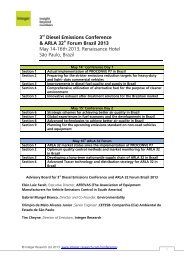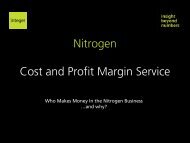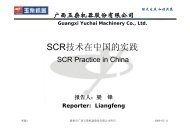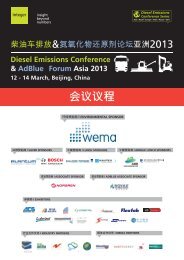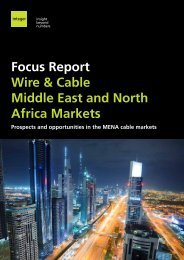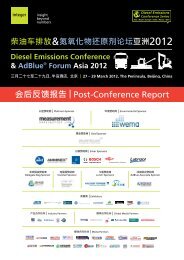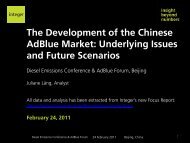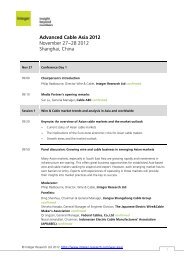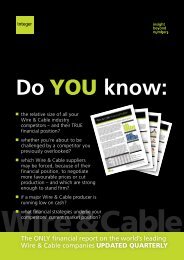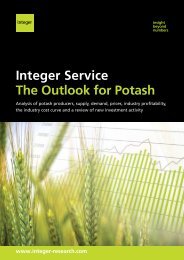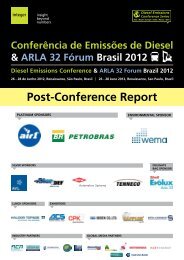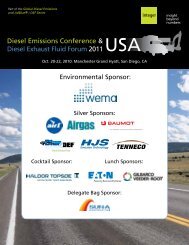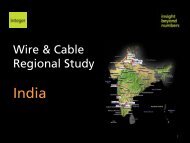Conference Summary - Integer Research
Conference Summary - Integer Research
Conference Summary - Integer Research
You also want an ePaper? Increase the reach of your titles
YUMPU automatically turns print PDFs into web optimized ePapers that Google loves.
Brazil *Europe<br />
*USA<br />
*Europe<br />
*India<br />
*USA<br />
beyond<br />
numbers<br />
Diesel Emissions<br />
<strong>Conference</strong> Series<br />
Asia | Brazil | Europe | India | Russia | USA<br />
Diesel Emissions <strong>Conference</strong> Series<br />
Asia | Brazil | India | Europe | USA<br />
Diesel Emissions <strong>Conference</strong> &<br />
Diesel Exhaust Fluid Forum 2011<br />
insight<br />
beyond<br />
numbers<br />
On-Highway | Off-Highway<br />
Oct. 17 - 19, 2011<br />
Four Seasons Hotel, Atlanta, USA<br />
<strong>Conference</strong> <strong>Summary</strong><br />
Diesel Emissions <strong>Conference</strong><br />
Global Platinum Sponsor<br />
Environmental Sponsor<br />
®<br />
& AdBlue Forum 2011<br />
Heavy Duty | Non Road | Light Duty<br />
15 – 17 June 2011, Hilton, Düsseldorf, Germany<br />
Delegate Badge Sponsor<br />
Silver Sponsors<br />
Lunch Sponsor<br />
Diesel Emissions <strong>Conference</strong><br />
Exhibitors<br />
®<br />
& AdBlue Forum 2011<br />
Media Partners
eyond<br />
numbers<br />
insight<br />
beyond<br />
numbers<br />
Contents:<br />
<strong>Conference</strong> summary ..................................................................................................3 - 16<br />
Attendee demographics ................................................................................................... 17<br />
Testimonials ..................................................................................................................... 18<br />
Closing remarks ................................................................................................................ 19<br />
<strong>Integer</strong> & <strong>Conference</strong>s<br />
<strong>Integer</strong> <strong>Research</strong> is a provider of key business information, market forecasts and commercial strategy consulting. We<br />
are not a ‘conference company.’ <strong>Conference</strong>s are simply an extension of our core business. It is the reputation of<br />
<strong>Integer</strong>, our market knowledge, and our contacts that enable us to produce the industry’s leading Diesel Emissions<br />
<strong>Conference</strong> series. This places <strong>Integer</strong> in a unique and privileged market position and allows us to provide the industry<br />
with a comprehensive forum to meet, discuss and debate on the latest industry issues.<br />
In 2012, the Diesel Emissions <strong>Conference</strong> Series will cover Russia & CIS, Asia, South America, Europe, India and North<br />
America.<br />
<strong>Conference</strong> <strong>Summary</strong>: Diesel Emissions <strong>Conference</strong> and DEF Forum, USA 2011<br />
2
eyond<br />
numbers<br />
<strong>Conference</strong> <strong>Summary</strong><br />
insight<br />
beyond<br />
numbers<br />
In what was the biggest ever <strong>Integer</strong> event<br />
in the US, the Diesel Emissions <strong>Conference</strong><br />
and DEF Forum 2011 saw over 200 senior<br />
stakeholders packed into one room to<br />
engage in focused discussions on the<br />
developments in the DEF, on-highway and<br />
off-highway markets.<br />
DEF Forum (Oct. 17)<br />
The Forum opened with a thought-provoking<br />
introduction from <strong>Integer</strong>’s Director of Emissions,<br />
Tim Cheyne, who started by congratulating DEF<br />
stakeholders for the growing success of the US DEF<br />
market. However, he also highlighted the importance<br />
of improving infrastructure to meet increasing<br />
demand for DEF, as more and more fleet operators<br />
choose SCR to achieve lower NOx emissions and<br />
improved fuel economy.<br />
DEF testing and certification<br />
Jeffrey Harmening from the American Petroleum<br />
Institute (API) followed with a presentation on what<br />
the API has done to certify DEF in the US, since<br />
handing out its first licence in March 2009. Jeffrey<br />
highlighted some of the certification challenges<br />
experienced in the ISO 22241 monitoring program,<br />
and provided a summary of audit results in 2010.<br />
The API now certifies 28 DEF brands, but more are<br />
expected due to the increase in popularity towards<br />
SCR.<br />
<strong>Conference</strong> <strong>Summary</strong>: Diesel Emissions <strong>Conference</strong> and DEF Forum, USA 2011<br />
3
eyond<br />
numbers<br />
insight<br />
beyond<br />
numbers<br />
DEF Tracker<br />
Prices and supply locations,<br />
updated every month<br />
NEW SERVICE LAUNCH<br />
DEF prices<br />
Trends and<br />
key figures<br />
Emerging<br />
benchmarks<br />
Market<br />
intelligence<br />
Supply network<br />
RECEIVE THE FIRST ISSUE FREE - REGISTER YOUR INTEREST<br />
Email publications@integer-research.com or call +1 718 705 4735<br />
<strong>Conference</strong> <strong>Summary</strong>: Diesel Emissions <strong>Conference</strong> and DEF Forum, USA 2011<br />
4
eyond<br />
numbers<br />
<strong>Conference</strong> <strong>Summary</strong> (cont.)<br />
insight<br />
beyond<br />
numbers<br />
Market trends and user experience<br />
Chris Goodfellow of <strong>Integer</strong> <strong>Research</strong><br />
led the next session by providing<br />
useful statistics on the amount of<br />
SCR equipped trucks on US roads,<br />
and the market share of each of<br />
the big on-highway manufacturers.<br />
Following this, Chris gave detailed<br />
information on the consumption<br />
of DEF by state and, from findings<br />
contained in the AdBlue and DEF<br />
Monitor, provided information on the<br />
steep increase of DEF retail locations,<br />
including the first sites in Canada.<br />
Chris concluded with pricing trends<br />
across the US, for totes, jugs and<br />
pumps.<br />
James Thomas, Fuel Optimization<br />
Manager at PepsiCo followed to<br />
give the hugely-valued perspective<br />
from the end user on DEF supply<br />
and infrastructure in practice.<br />
James put in perspective the needs<br />
of a big fleet when it comes to<br />
DEF consumption, and shed some<br />
light on the fuel efficiency gains<br />
experienced by PepsiCo, which has<br />
led to savings as high as 20%. James<br />
also touched on other applications<br />
being used by PepsiCo, including<br />
hybrid technologies and concluded<br />
with a comment which was echoed<br />
throughout the day – the priorities<br />
have moved from DEF pricing to<br />
setting up the right partnerships and<br />
getting the right service to meet their<br />
needs.<br />
To continue discussions on user<br />
experience, Tim welcomed up a set<br />
of panellists to the stage to consider<br />
how DEF distributors can satisfy<br />
the needs of on-highway, offhighway<br />
and vocational fleets. The<br />
discussions started with comments<br />
from Michael DelliCompagni of<br />
Brenntag, who highlighted the<br />
shift in distribution needs over<br />
the years and the importance of<br />
building strong partnerships. Doug<br />
Haugh from Mansfield Oil Company<br />
followed by presenting discussions<br />
with fleets on capital investments<br />
being made in SCR trucks, and a<br />
movement from “are we going to do<br />
this?”to “how are we going to do<br />
this?”. James Thomas reiterated that,<br />
certainly in their case, the priorities<br />
have changed from price (which has<br />
now been driven down by intense<br />
competition in the DEF market) to<br />
service. He highlighted that the use<br />
of SCR trucks at PepsiCo was inspired<br />
by what had already been done<br />
in Europe, and he was particularly<br />
attracted by the potential fuel<br />
efficiency gains associated with SCR<br />
technology. Brian Spencer of CNH<br />
global then gave an interesting view<br />
from the off-highway perspective.<br />
He mentioned that the speed of<br />
understanding regarding SCR in the<br />
agricultural industry was slow, but<br />
adoption of the technology was quick<br />
once they understood the impact<br />
that it will have on their operations.<br />
Brian mentioned that farmers are<br />
used to working with chemicals, and<br />
therefore DEF will not have a huge<br />
impact on their business. Brian went<br />
on to mention that farmers are more<br />
concerned with the supply of DEF,<br />
and deciding how best to handle the<br />
chemical in 2012. Early adopters are<br />
reporting better fuel economy, and<br />
early signs are positive. Doug then<br />
stressed the need for innovation for<br />
the off-highway market, as supply<br />
to the market will not be a “one size<br />
fits all service”. The panel concluded<br />
with the issue of quality, which<br />
didn’t seem to be of huge concern.<br />
However, Michael stressed the<br />
dangers in the difference between<br />
the users’ perception of quality and<br />
actual quality.<br />
<strong>Conference</strong> <strong>Summary</strong>: Diesel Emissions <strong>Conference</strong> and DEF Forum, USA 2011<br />
5
eyond<br />
numbers<br />
<strong>Conference</strong> <strong>Summary</strong> (cont.)<br />
insight<br />
beyond<br />
numbers<br />
New opportunities in the DEF market<br />
Following his input in the panel, Doug Haugh of<br />
Mansfield Oil Company gave some more views on<br />
DEF supply strategy to the off-highway sector. Doug<br />
started with a call for all DEF stakeholders to start to<br />
plan for the market now, while OEMs are still preparing<br />
their storage and dispensing strategies. Again, Doug<br />
touched on the issue of quality, and explained how<br />
OEMs are educating customers on the best ways to get<br />
DEF from the pump to the tank.<br />
Chuck Mattina from The Quixote Group followed<br />
with a set of interesting statistics on the distribution,<br />
packaging and pricing trends for the vocational fleet<br />
market. Chuck discussed how vocational fleets are<br />
storing and dispensing DEF fuel, and gave some<br />
informative statistics on vehicle types still using EGR<br />
as the technology method for achieving emissions<br />
compliance.<br />
This was followed by another panel discussion on the<br />
distribution strategies for segmented markets such as<br />
off-highway and marine. The panel kicked off with a<br />
discussion on the off-highway market. Lyle Westerfield<br />
from KostUSA said that there is need for a better<br />
understanding of how to handle the product and<br />
the complexity of it all, as non-road end users had to<br />
quickly get to grips with using DEF. Dr. Frank Cook<br />
commented that the DEF market is ready, and now<br />
the market just needs education. Chad Dombroski of<br />
Yara North America Inc. provided some information<br />
on Yara’s tailored solutions for marine applications,<br />
and some of the unique challenges which separate it<br />
from other markets. The panel concluded that building<br />
strong relationships with end users and intermediaries<br />
will be the key to success in these markets.<br />
<strong>Conference</strong> <strong>Summary</strong>: Diesel Emissions <strong>Conference</strong> and DEF Forum, USA 2011<br />
6
eyond<br />
numbers<br />
<strong>Conference</strong> <strong>Summary</strong> (cont.)<br />
insight<br />
beyond<br />
numbers<br />
DEF delivery, storage and dispensing technologies<br />
Next, Tod Dressler from FedEx Ground gave another interesting and important perspective from the end user. Tod<br />
went into some detail surrounding the events leading to FedEx’s strategy of implementing underground bulk storage<br />
of DEF over IBCs, offering optimum cost effectiveness in the long term. He also discussed the solutions being used,<br />
including dual fuel and DEF installations.<br />
This was followed by a frank discussion on bulk filling equipment technology, and the experiences of equipment<br />
suppliers. First, the panel discussed the latest innovations that they had witnessed or invented for the market. Multicompartment<br />
solutions, positions of the filling tank and weather-adept solutions were discussed by the panellists,<br />
who also highlighted the benefits that these solutions had for their clients. The panel went on to discuss their surprise<br />
at the speed of adoption of underground bulk solutions. Rick Whately from Xerxes emphasized how, in a matter of a<br />
few years, the number of systems have gone from none to hundreds – much faster than expected. Stephen Cox from<br />
Separation by Design highlighted the sheer diversity of applications needed for the market. They also discussed the<br />
unpredictability of the market, and the difficultly in forecasting such a complex and ever-evolving market. The panel<br />
also discussed developments of new, dynamic technologies which are necessary to improve client experience and<br />
serve the more complicated off-highway market. The panel concluded that although this is a short term market which<br />
will inevitably end with few players focused on servicing rather than developing new installations, there are many<br />
profitable opportunities which can be taken advantage of now due to the size of the potential market.<br />
<strong>Conference</strong> <strong>Summary</strong>: Diesel Emissions <strong>Conference</strong> and DEF Forum, USA 2011<br />
7
eyond<br />
numbers<br />
<strong>Conference</strong> <strong>Summary</strong> (cont.)<br />
insight<br />
beyond<br />
numbers<br />
Diesel Emissions <strong>Conference</strong> (Oct 18)<br />
This year’s conference shifted in focus from<br />
NOx to CO2 – the next challenge on the route<br />
to near zero emissions in the US.<br />
GHG and fuel economy<br />
Following a welcome from <strong>Integer</strong>’s<br />
Tim Cheyne, Rakesh Aneja of Daimler<br />
Trucks kicked off the conference<br />
with his views on how technology<br />
will develop to lower greenhouse<br />
gas emissions by 2014. In an<br />
insightful presentation, Rakesh gave<br />
some background on GHG and<br />
fuel economy standards and how<br />
these tie in with other emissions<br />
legislation for on-highway vehicles.<br />
Following data on NOx reduction<br />
achievements and fuel consumption<br />
gains, Rakesh discussed Daimler’s<br />
SuperTruck program – a set of<br />
internal emissions reduction targets<br />
beyond the 2013-14 GHG legislation.<br />
This included a 50% improvement in<br />
thermal efficiency, and the inclusion<br />
of predictive technologies that will<br />
allow the truck to adjust its power<br />
output according to its surrounding<br />
environment.<br />
Next, Tony Greszler of Volvo<br />
Group, provided another view on<br />
achieving GHG reductions and fuel<br />
efficiency. He opened with some<br />
background information on NOx level<br />
achievements to date, stating that<br />
the industry has “won the war” on<br />
NOx, and fuel efficiency is now the<br />
“new front for diesel engineers”.<br />
Tony stated that they have seen<br />
5% fuel efficiency gains through<br />
SCR technology, and provided an<br />
interesting video of his technology in<br />
action. Tony went on to discuss some<br />
of the technologies being developed<br />
by Volvo, including intelligent<br />
transmissions, aerodynamics and<br />
testing methods. Similar to Daimler,<br />
Volvo also has internal targets to<br />
further improve fuel efficiency<br />
and GHG reductions, including a<br />
20% increase in engine efficiency<br />
demonstrated on-highway by 2015.<br />
Next, Tim welcomed a panel made up<br />
of all the biggest on-highway OEMs<br />
in the US – Daimler, Volvo, Kenworth<br />
Trucks, Navistar and Cummins.<br />
The conversation began with the<br />
panellists discussing the opportunities<br />
and challenges they face from CO2<br />
and fuel efficiency targets. Judy<br />
McTigue of Kenworth Trucks began<br />
by saying that although the ultimate<br />
goal of reducing CO2 emissions is<br />
valid, there is still a lot of uncertainty<br />
surrounding GHG and fuel economy<br />
requirements. Rakesh Aneja agreed<br />
that the regulators have made a<br />
good first step, giving “customers<br />
something that they actually want”<br />
on fuel efficiency cost savings.<br />
However, Rakesh suggested that to<br />
achieve the best results, regulation<br />
should be applied to the entire truck,<br />
including the trailer and tyres. Ken<br />
Federle of Cummins was first to<br />
highlight the need to ensure that<br />
the engine is cost effective for the<br />
end user, and that the benefits are<br />
properly communicated to customers.<br />
Ken also highlighted the need to<br />
think about the entire spectrum<br />
when achieving fuel efficiency,<br />
including education for the depots on<br />
loading freight correctly. The panel<br />
then touched on alternative fuels and<br />
technologies, including natural gas,<br />
biodiesel and hybrid, and the roles<br />
that they can play in achieving fuel<br />
efficiency targets.<br />
<strong>Conference</strong> <strong>Summary</strong>: Diesel Emissions <strong>Conference</strong> and DEF Forum, USA 2011<br />
8
eyond<br />
numbers<br />
insight<br />
beyond<br />
numbers<br />
<strong>Integer</strong> Publications<br />
Environment & Emissions<br />
Make key decisions faster with our professional suite of reports<br />
DEF Tracker - new service launch<br />
Prices and supply locations updated every month - with trends and key<br />
figures, emerging benchmarks, market intelligence and supply network<br />
AdBlue & DEF Monitor<br />
Data every 3 months from key parts of the AdBlue and DEF supply chain,<br />
including prices, production, input costs and consumption<br />
SCR and the Non-Road Mobile<br />
Machinery (NRMM) Market<br />
Off highway sales and parc data analysis, coupled with AdBlue<br />
& DEF consumption estimates and supply strategies<br />
Brazil Diesel Emissions &<br />
ARLA 32 Market Study 2011<br />
Brazil emissions and fuel legislation, fuel quality, OEM plans, ARLA 32<br />
volumes & forecasts, supply and market structure and demand<br />
China Diesel Emissions &<br />
AdBlue Market Study 2011<br />
Chinese emissions and fuel legislation, fuel quality, OEM plans, AdBlue<br />
market information, market structure and demand<br />
Stationary SCR in the USA<br />
Analysis of the implications of major structural changes the ammonia<br />
and urea SCR market is going through<br />
To find out more about how <strong>Integer</strong> can help you call +44 20 7503 1265,<br />
email publications@integer-research.com or visit www.integer-research.com<br />
<strong>Conference</strong> <strong>Summary</strong>: Diesel Emissions <strong>Conference</strong> and DEF Forum, USA 2011<br />
9
eyond<br />
numbers<br />
<strong>Conference</strong> <strong>Summary</strong> (cont.)<br />
insight<br />
beyond<br />
numbers<br />
Aftertreatment technology strategy for commercial advantage<br />
Robert Bosch’s Engineering Manager, Juergen Zybel, was<br />
next to give his views on the aftertreatment technologies<br />
available to achieve fuel economy improvements.<br />
In what was a comprehensive presentation on the<br />
technologies being used in the market, Juergen<br />
discussed those being developed by Robert Bosch,<br />
including waste heat recovery and hybrid technologies.<br />
His presentation however, was focused on his company’s<br />
DEF injection units, which their tests show to reduce<br />
NOx emissions without the use of DPF.<br />
Ed VanDyne of VanDyne SuperTurbo Inc. gave a detailed<br />
overview of the technologies which could be used to<br />
achieve fuel efficiency gains, including aerodynamics,<br />
hybrid technologies and additives. This led into an<br />
explanation of his technology, and an entertaining video<br />
on how it works.<br />
Steve Majkowski from Dow Automotive followed with<br />
a presentation on AERIFY filter technology, and the<br />
advantages for filtration efficiency.<br />
<strong>Conference</strong> <strong>Summary</strong>: Diesel Emissions <strong>Conference</strong> and DEF Forum, USA 2011<br />
10
eyond<br />
numbers<br />
<strong>Conference</strong> <strong>Summary</strong> (cont.)<br />
insight<br />
beyond<br />
numbers<br />
On-board diagnostics rules and technical approaches<br />
Following a productive networking break, Judy McTigue from Kenworth Trucks<br />
gave an outstanding overview of the OBD rules for heavy duty trucks in the US.<br />
Judy began by going into some detail on what the rules will cover, and what<br />
electrical and mechanical faults the system is expected to detect. Judy also stated<br />
at this point that there should be no illusion that OBD compliance will be an easy<br />
achievement, requiring developments in both hardware and software. Judy outlined<br />
these one by one, showing visuals on the technologies and the customization<br />
which needs to be made. This includes sensors for DPFs and DEF tanks, as well<br />
as dashboard warning light changes. Judy went on to discuss the role of hybrid<br />
technology in complying with OBD rules, mentioning that CARB and EPA have<br />
yet to announce the requirements for hybrids. To conclude, Judy stated that OBD<br />
compliance will not be a “cheap endeavour”, and will require significant investment<br />
by OEMs without any monetary ROI. The customer experience will not be disturbed<br />
greatly, but it is important that communications and training on the changes to<br />
systems begins now.<br />
Dr Stephen Charlton from Cummins discussed the harmonization of OBD<br />
between US and EU. Building on the previous presentation by Judy McTigue,<br />
Stephen discussed the key technologies which need to be developed for OBD<br />
requirements, including DEF, electronic controls, combustion technologies and<br />
turbos. He went on to mention the OBD fitted trucks which are on the road today,<br />
will need to be adapted to comply with the new rules. Then, Stephen outlined the<br />
differences between US and Europe in areas such as emissions types, threshold<br />
levels and demonstration cycles. Stephen shared some interesting statistics on<br />
cost comparisons of meeting OBD requirements for EPA 2010 and Euro V, and<br />
projections for EPA 2013 and VI, which show large differences in cost. In conclusion<br />
Stephen mentioned that harmonization between Europe and the US could lead to<br />
significant cost savings for the OEM, and ultimately, the end user.<br />
This was followed by presentations from Measurement Specialities and Wema, who<br />
discussed their sensing technologies for AdBlue.<br />
<strong>Conference</strong> <strong>Summary</strong>: Diesel Emissions <strong>Conference</strong> and DEF Forum, USA 2011<br />
11
eyond<br />
numbers<br />
<strong>Conference</strong> <strong>Summary</strong> (cont.)<br />
insight<br />
beyond<br />
numbers<br />
Emerging emissions reduction opportunities for OEMs and equipment suppliers<br />
In the last session of the day and<br />
in keeping with the theme of<br />
harmonization, Manfred Schuckert<br />
from Daimler began by discussing<br />
the benefits for creating worldwide<br />
GHG emission reduction strategies<br />
for heavy duty vehicles. Manfred<br />
stated that he expects to see the<br />
implementation of CO2 emissions<br />
targets by 2018/2019 in the US,<br />
alongside the 2020 targets of<br />
Japan and China. After a detailed<br />
explanation on the position of Japan,<br />
Europe and China, like Dr Stephen<br />
Charlton, Manfred stressed the cost<br />
advantages of globally harmonized<br />
rules to leverage the opportunities<br />
available. Manfred also went into<br />
detail on what this should cover,<br />
including cycle definitions (shape and<br />
load of trucks), testing procedures<br />
(on aerodynamics, tyres etc.), and use<br />
of the same simulation tools.<br />
The Day ended with a panel<br />
discussion which featured leading<br />
policy organisations from the heavy<br />
duty industry. Each panellist took it<br />
in turn to give their view on how the<br />
new GHG rules will affect OEMs and<br />
the opportunities available to the<br />
industry as a result. Dave Piech from<br />
Navistar began by voicing his concern<br />
about the legislation, and the impact<br />
that this will have on everyone<br />
within the market. He called on the<br />
industry to engage with government<br />
to ensure that the impact on the<br />
end user is not too extreme. Bill Van<br />
Amburg started with an introduction<br />
of his company CalSTART, the work<br />
that has already been done within<br />
the industry, and then went on to<br />
discuss harmonisation. His comments<br />
mimicked those of Connie Burek<br />
of IBM Global Services, who also<br />
provided some insight from their<br />
report Truck 2020. Connie called for<br />
OEMs and other government bodies<br />
to consider all of the factors of<br />
efficiency, giving an example showing<br />
that, from findings taken from their<br />
research, 30% of traffic congestion<br />
is due to drivers looking for parking<br />
spaces, and thus consuming diesel<br />
fuel unnecessarily. Following an<br />
introduction of her association, Fanta<br />
Kamakate from ICCT provided some<br />
insight on developments taking<br />
place around the world concerning<br />
diesel emissions legislation. This<br />
included confirmation that Canada<br />
and Mexico will harmonize their<br />
diesel emissions legislation with<br />
the US. Fanta highlighted the<br />
importance of communicating these<br />
changes early, a feeling echoed<br />
by Manfred Schuckert. The panel<br />
went on to discuss the real impact<br />
on OEMs and customers, and<br />
what the industry could look like<br />
in the next 10 years. The group all<br />
agreed that enforcement will play a<br />
huge part in making sure the rules<br />
are implemented correctly, and<br />
highlighted the real danger of the<br />
rules having further consequences<br />
in the market, such as a slowdown<br />
in vehicle registrations. All panellists<br />
agreed that whatever is decided<br />
should be communicated effectively<br />
to all industry stakeholders to ensure<br />
that the process is as efficient as the<br />
engines being created.<br />
<strong>Conference</strong> <strong>Summary</strong>: Diesel Emissions <strong>Conference</strong> and DEF Forum, USA 2011<br />
12
eyond<br />
numbers<br />
<strong>Conference</strong> <strong>Summary</strong> (cont.)<br />
insight<br />
beyond<br />
numbers<br />
Diesel Emissions <strong>Conference</strong> (Oct 19)<br />
Chamila Tissera from the Deutz Corporation kick started<br />
a day focused on the off-highway market. With a clear<br />
synergy to the previous day’s on-highway sessions, the<br />
conference discussed issues around legislation (Tier 4<br />
Interim and Final), GHG reduction and fuel economy.<br />
Chamila gave an overview of the off-highway market,<br />
and outlined the stark differences between off and onhighway<br />
certification. However, he said that the core<br />
technologies being used by the on-highway market<br />
are the same. With a 4 year gap between legalisation<br />
levels for the on- and off-highway markets, onhighway<br />
acted as the perfect “guinea pig” for these<br />
technologies. It was said earlier in the day that a ‘one<br />
size fits all’ approach does not work in the off-highway<br />
sector. Deutz are using a combination of SCR and EGR<br />
equipped trucks to achieve Tier 4 standards. However,<br />
their focus is on SCR + DPF for the heavier categories.<br />
Chamila then led into his key topic of discussion -<br />
certification - discussing the strawmen document, which<br />
was originally meant to be a guideline on ensuring the<br />
truck is achieving the emissions reduction via DEF, but<br />
eventually became law. Going step-by-step through<br />
the certification process, Chamila covered subjects such<br />
as the driver warning display lights, the requirements<br />
of a DEF sensor and freeze protection. He then went<br />
on to highlight the difficulties of establishing a DEF<br />
infrastructure for the off-highway market, especially<br />
in extreme locations. Chamila ended his presentation<br />
with some interesting data from CARB, showing<br />
the emissions results of the 8 biggest off-highway<br />
manufacturers.<br />
Joseph Featherstone from John Deere Power Systems<br />
next provided a case study on how they achieved Tier 4<br />
interim. Following an overview of the company, which<br />
offers vehicles and engines for a range of applications<br />
up to 10,000ft above sea level, he gave an insightful<br />
overview of John Deere’s strategy for achieving Tier 4<br />
interim. Joseph shared some feedback received from<br />
customers including the things they demanded from<br />
the new engines, which broke down as reliable, cost<br />
effective, powerful vehicles with a single fluid solution.<br />
Joseph went through John Deere’s building block<br />
approach, resulting in a cooled EGR with DPF solution,<br />
and went on to say that their customers were seeing<br />
fuel efficiency gains. He discussed the steps that John<br />
Deere took to get there, including educating the entire<br />
supply chain from the dealers to the customer. Feedback<br />
from their customers has shown that their solution has<br />
achieved its goals, it incurred no major disturbances<br />
to the customers’ normal operations, the new power<br />
and performance was received well, and there was<br />
satisfaction from customers that they did not have to<br />
use any additional fluids. When asked by the audience<br />
about John Deere’s view on using SCR, Joseph was<br />
unable to comment on whether this technology will be<br />
used to achieve Tier 4 Final.<br />
<strong>Conference</strong> <strong>Summary</strong>: Diesel Emissions <strong>Conference</strong> and DEF Forum, USA 2011<br />
13
eyond<br />
numbers<br />
insight<br />
beyond<br />
numbers<br />
<strong>Integer</strong> Focus Report<br />
SCR and the Non-Road Mobile<br />
Machinery (NRMM) Study<br />
Manage your off-highway SCR<br />
strategy with our new study<br />
OEM-by-OEM guide to SCR use<br />
Standardised Legislative timeline analysis<br />
Analysis of major NRMM equipment<br />
markets: 2010-2020<br />
AdBlue/DEF consumption estimates<br />
Insight into global urea production<br />
and regional AdBlue/DEF supply<br />
Gain<br />
deeper<br />
insight<br />
into the<br />
NRMM<br />
market<br />
<strong>Conference</strong> <strong>Summary</strong>: Diesel Emissions <strong>Conference</strong> and DEF Forum, USA 2011<br />
14
eyond<br />
numbers<br />
<strong>Conference</strong> <strong>Summary</strong> (cont.)<br />
insight<br />
beyond<br />
numbers<br />
Next, Par Gabrielson from Haldor Topsoe looked at cost<br />
effective compliance at Stage IV/Tier 4 final and beyond.<br />
Working with TNO, Haldor Topsoe gave figures on costs<br />
for SCR only, SCR + EGR and EGR only alternatives<br />
– costs which ultimately have to be absorbed by<br />
the customer. Par also went into some detail on the<br />
different applications being used around the world.<br />
John Rogers of AGCO followed to give a comprehensive<br />
overview of the technologies they will be using to meet<br />
future emissions standards. AGCO chose internal EGR<br />
for Tier 3 / Stage 3a, but was the first off-highway<br />
manufacturer to introduce SCR technology on their<br />
vehicles from 2008. John went on to say that AGCO<br />
saw a swing in orders from 80% EGR and 20% SCR<br />
equipped applications, to 80% SCR and 20% EGR in<br />
a matter of years. He did however say that they are<br />
constantly monitoring the price of DEF, to ensure that<br />
it is still a cost effective solution for their customers. He<br />
also said that when they set off down the SCR route<br />
in 2008, DEF infrastructure was their largest concern,<br />
but customers are now comfortable with using it. John<br />
also highlighted some of the other market conditions<br />
considered when deciding on the best solutions for their<br />
customers, including the price of diesel and biodiesel,<br />
and the variety of tasks that each application is used for<br />
with different needs in power and performance. John<br />
could not comment on the route that AGCO would take<br />
to Tier 4 Final, but said like every manufacturer, they will<br />
wait until the last minute to announce their solution to<br />
ensure that they make full use of the latest technologies<br />
in the market.<br />
Marc Hehle from MTU moved the discussion on to the<br />
rail segment of the NRMM market and the technologies<br />
being considered to achieve lower emissions. Marc<br />
spoke about the two common routes being used in<br />
the rail sector to achieve the next stage of legislation<br />
in 2015; EGR and DPF and SCR and DPF, and provided<br />
a case study of a recent test with an SCR solution.<br />
The field trials took place between 2008 and 2010 –<br />
totalling 450000 hours of operation. He spoke about<br />
some of the challenges they faced with getting the<br />
retrofit technology to work with existing machinery,<br />
which was a difficult task because of the limited space<br />
surrounding locomotive engines. Other challenges<br />
highlighted include certification (they could not make<br />
changes to the engine as it was certified) and DEF<br />
infrastructure at the beginning of the trials. Marc<br />
concluded his presentation with the point that there<br />
are many solutions still be considered, and stressed<br />
that different rail applications will require different<br />
aftertreatment systems.<br />
<strong>Conference</strong> Chairman and <strong>Integer</strong>’s Director of<br />
Emissions, Tim Cheyne was next to present findings<br />
from the SCR & NRMM study. The presentation included<br />
statistics contained in the study, including forecasts on<br />
equipment volumes, infrastructure and consumption of<br />
DEF by the non-road market.<br />
Further information on the SCR & NRMM study can be<br />
found here.<br />
<strong>Conference</strong> <strong>Summary</strong>: Diesel Emissions <strong>Conference</strong> and DEF Forum, USA 2011<br />
15
eyond<br />
numbers<br />
<strong>Conference</strong> <strong>Summary</strong> (cont.)<br />
insight<br />
beyond<br />
numbers<br />
Ravi Godbole from AGCO closed the conference<br />
with views on current fleet efficiency strategies. In<br />
a presentation focused on non road vehicle fleets/<br />
owners getting more for less, Ravi went through a<br />
variety of innovations which are under development<br />
at AGCO to improve fuel economy and minimize GHG<br />
emissions. These included weight optimization, duel fuel<br />
approaches and hybridization. There was a focus on<br />
the right fuel in this presentation – what will give the<br />
optimum power for the least cost. Ravi discussed Brazil’s<br />
method of using biodiesel and diesel interchangeably<br />
depending on the current price of each fuel, and also<br />
considered what else could be mixed with diesel to<br />
create efficient fuels. He went on to discuss AGCO’s<br />
future solutions, which include diesel electric and<br />
hydrogen fuel cells, and also revealed some concepts<br />
currently being tested. This included the launch of the<br />
e-rogator – an electic hybrid application which is said<br />
to achieve 25% in fuel savings and GHG reduction<br />
compared to standard diesel. He closed by saying that<br />
going forward 10 to 15 years, fuel cell and electric<br />
drive vehicles will be the future of the non-road market,<br />
although he felt we have not perfected the technology<br />
yet.<br />
<strong>Conference</strong> <strong>Summary</strong>: Diesel Emissions <strong>Conference</strong> and DEF Forum, USA 2011<br />
16
eyond<br />
numbers<br />
Attendee Demographics<br />
insight<br />
beyond<br />
numbers<br />
E<br />
F<br />
G<br />
Company Type<br />
C<br />
D<br />
A<br />
A AdBlue Manufacturer/ Urea Producer/ Equipment Supplier/ 33%<br />
Distributor<br />
B Aftertreatment systems/ Auto. Parts/ Testing/ Raw 32%<br />
materials<br />
C Vehicle and/or Engine Manufacturer 19%<br />
D Oil, Fuels and Lubricants Producer/ Supplier/ Distributor 7%<br />
E Government/ Legislator/ Association/ <strong>Research</strong> Insitute 4%<br />
F Fleet (Public/ Private)/ Truck Stop 3%<br />
G Other 2%<br />
B<br />
Almost 1 in 5 attendees were vehicle or engine manufacturers<br />
of on- and off-highway vehicles.<br />
Job Title<br />
A Owner/ President/ VP/ Partner/ C-suite/ Director 40%<br />
B Senior Manager/ Country Manager/ Program Manager/ 24%<br />
Supply Chain Manager<br />
C Senior Engineer/ Engineer/ Design/ Product Manager 18%<br />
D Business Development/ Marketing/ Sales 14%<br />
E Regulation Analyst/ Regulation Specialist/ <strong>Research</strong>er 2%<br />
F Other 2%<br />
C<br />
D<br />
E<br />
F<br />
A<br />
The conference maintained its reputation of attracting<br />
attendees of high seniority.<br />
B<br />
C<br />
D<br />
E<br />
Region<br />
B<br />
A United States 73%<br />
B Europe & Russia 15%<br />
C Canada 5%<br />
D Asia 4%<br />
E ROTW 3%<br />
A<br />
The conference attracted attendees from 22 different<br />
countries.<br />
<strong>Conference</strong> <strong>Summary</strong>: Diesel Emissions <strong>Conference</strong> and DEF Forum, USA 2011<br />
17
eyond<br />
numbers<br />
Testimonials<br />
insight<br />
beyond<br />
numbers<br />
“The best DEF <strong>Conference</strong> around”<br />
Bryan Brunner, Cummins Inc<br />
“Very useful, knowledgeable, real world info.”<br />
Ayyappan Ponnaiyan, John Deere PEC<br />
“A must attend for anyone in the industry”<br />
Ross Ayrhart, Wakefield Canada<br />
“Most comprehensive overview for the DEF<br />
Market”<br />
Joseph J Hiznay, Colonial Chemical Company<br />
“Excellent opportunity for networking. Good<br />
overview of North America”<br />
Ellis Rowe, GT Group<br />
“A great mold of minds amoung the Diesel<br />
Industry”<br />
Jeffrey Harmening,<br />
American Petroleum Institute (API)<br />
“Pretty good, would encourage my colleagues<br />
to attend next year”<br />
Lee Liu, ASIMCO Technologies Limited<br />
“Worth coming back”<br />
Ed VanDyne, VanDyne SuperTurbo, Inc.<br />
“Very candid conversation about emissions<br />
technology and strategies”<br />
Tom Grotophorst, Modine<br />
“Discussions of the latest emissions control<br />
issues in the diesel engine markets”<br />
Stephanie Bogner, Parker Hannifin Corp.<br />
“I was on a fact finding mission and certainly<br />
gathered a lot of facts”<br />
Mark Michalkoff, Oleo Energies, Inc.<br />
“Very Informational”<br />
Brian Wohlscheid, Brenner Oil Company<br />
“Quality information that can have a strong<br />
impact on a self striving business”<br />
Geoff Bohlender, PPC Lubricants<br />
“Worthwhile”<br />
Eric Johnson, CSX Transportation<br />
“Good conference to learn about industry<br />
trends and regulations”<br />
Steven Powell, Parker Hannifin<br />
“Good speakers with a wide range of<br />
knowledge but limited technical content”<br />
Brendan Sherry, Tognum America Inc<br />
“Very good fluid conference”<br />
Josh Dresher, FW Murphy<br />
“A report out/update of industry players<br />
from their point of view.”<br />
Mike Daly, John Deere Power System<br />
<strong>Conference</strong> <strong>Summary</strong>: Diesel Emissions <strong>Conference</strong> and DEF Forum, USA 2011<br />
18
eyond<br />
numbers<br />
Closing Remarks<br />
insight<br />
beyond<br />
numbers<br />
Thank you for supporting this year’s conference. We hope that you found the event, and this<br />
document, useful for yourself and for your organization. Please do not hesitate to contact<br />
me if you have any further questions.<br />
Best wishes for the future,<br />
Amy Edwards<br />
Director - <strong>Conference</strong>s<br />
Tel:+44 20 7503 1265<br />
www.integer-research.com/conferences<br />
Our 2012 Diesel Emissions <strong>Conference</strong> Series:<br />
Diesel Emissions <strong>Conference</strong> Russia & CIS 2012<br />
7 - 8 February, Saint Petersburg, Russia<br />
Diesel Emissions <strong>Conference</strong> & AdBlue ® Forum Asia 2012<br />
27 - 29 March, Beijing, China<br />
Diesel Emissions <strong>Conference</strong> & AdBlue ® Forum Europe 2012<br />
29 - 31 May, Germany<br />
Diesel Emissions <strong>Conference</strong> & ARLA 32 Forum Brazil 2012<br />
26 - 28 June, Brazil<br />
Diesel Emissions <strong>Conference</strong> India 2012<br />
18 - 19 September, India *TENTATIVE<br />
Diesel Emissions <strong>Conference</strong> & DEF Forum USA 2012<br />
16 - 18 October, USA *TENTATIVE<br />
<strong>Conference</strong> <strong>Summary</strong>: Diesel Emissions <strong>Conference</strong> and DEF Forum, USA 2011<br />
19



